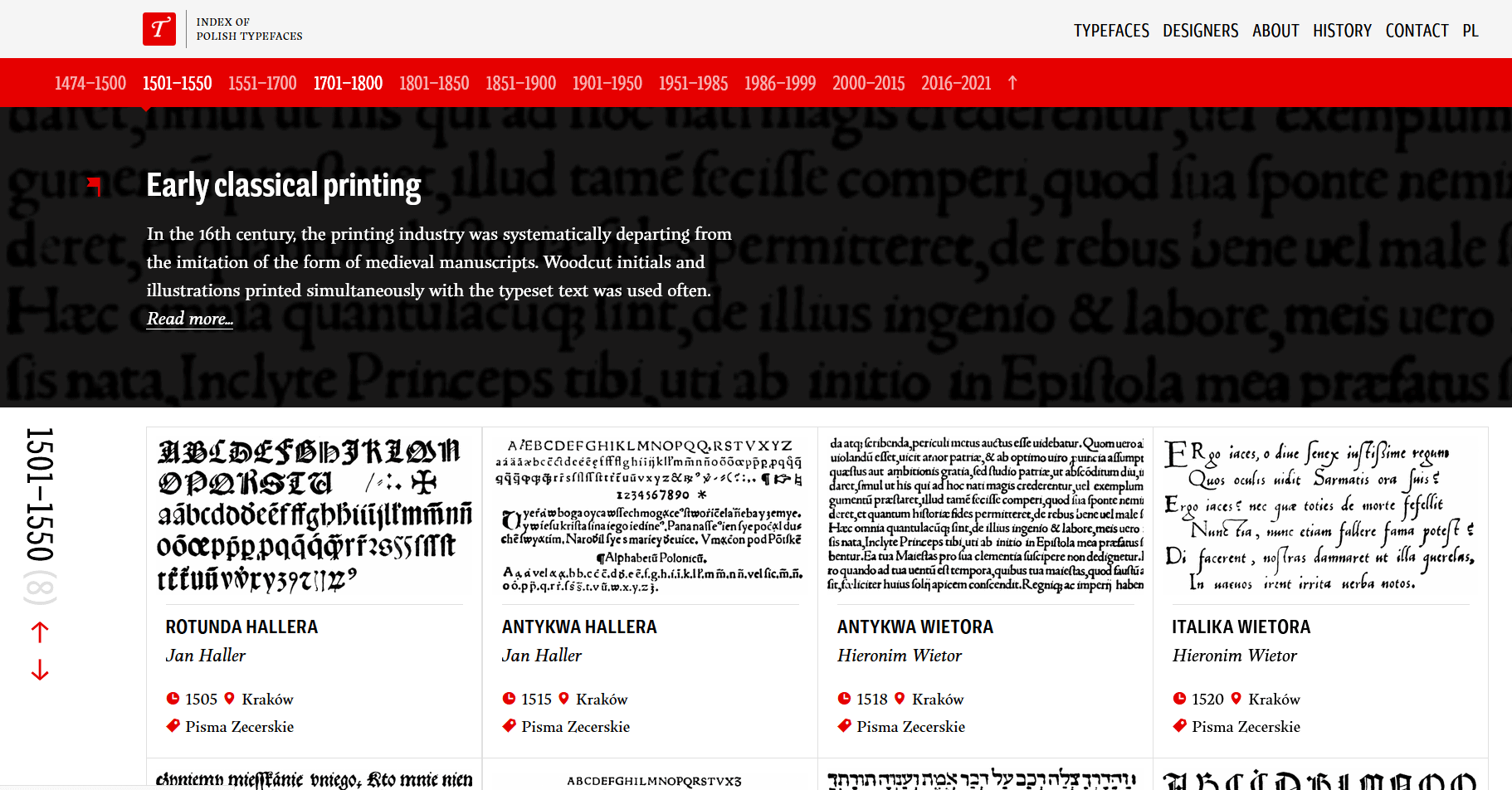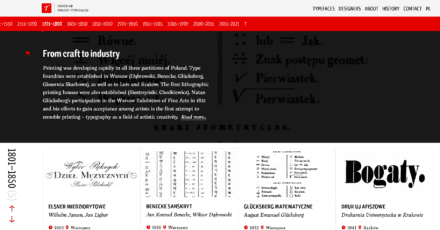The Typoteka website: almost 450 years of Polish typefaces
From our Australian correspondent, Jürgen Wegner, editor of The shadowland newsletter, Eastwood, New South Wales, Australia.
First published in The shadowland newsletter, n° 129, December 2021.
A bonus when you are sent a variety of digital publications such as newsletters is that they allow you to expand with your interests as in the opening of a flower. So I am always a keen reader of Sarah Bodman’s excellent monthly anthology, the Book arts newsletter. How does she do it? There is the information the Book arts newsletter contains—plus the countless illustrations of works in full colour. And when you scan this publication and see items of personal interest, then you can also follow the trail for further information.
 Such items can sometimes be painfully—annoyingly—brief, as was the mention in the last issue of the Book arts newsletter (no. 142 of November 2021) of the Polish website Typoteka. Described as an indeks polskich korójow pisma (Pol., index of Polish typefaces). And from here I’ll spare readers the Polish originals! The website Typoteka is professionally crafted. Unlike many foreign resources which only provide a small part of the website’s information when you click to access the English version, this website gives it all. The website has been created and is maintained by a team of six. Mateusz Machalski and Michał Jarociński, with Andrzej Tomaszewski the historical editor. Plus, three support members. Typoteka is a growing, living site and readers are encouraged to contribute any typefaces and their own information to the project.
Such items can sometimes be painfully—annoyingly—brief, as was the mention in the last issue of the Book arts newsletter (no. 142 of November 2021) of the Polish website Typoteka. Described as an indeks polskich korójow pisma (Pol., index of Polish typefaces). And from here I’ll spare readers the Polish originals! The website Typoteka is professionally crafted. Unlike many foreign resources which only provide a small part of the website’s information when you click to access the English version, this website gives it all. The website has been created and is maintained by a team of six. Mateusz Machalski and Michał Jarociński, with Andrzej Tomaszewski the historical editor. Plus, three support members. Typoteka is a growing, living site and readers are encouraged to contribute any typefaces and their own information to the project.
Which is a fine piece of work. At its heart is the directory of typefaces. My one and only criticism would be that there needs to be somewhere an index or alphabetical listing of all of the typefaces that are featured on this website—and there are many. Typefaces is the core, and this is displayed in a long timeline of type beginning with that of Kasper Straube’s ‘Gothic Antiqua Straube’. Each ‘author’ of type is given a brief or longer biography. There are hotlinks to date, to the period (e.g. Incunabula) where you can find other types from the period, and to the location (e.g. Cracow), as well as other types from a particular town and pisma zecerskie which, I believe, means typefaces. The types are arranged in eleven periods, the last two being 2000-2015 and the period 2016-2021 (but ongoing). So, we are very much up-to-date.
But a word from the About section of the website on the concept of ‘authors’ of type. As is stated here—and as I never tire of mentioning in the Shadowland newsletter:
‘Script [as in type—JW] is inherently international. An essential element of civilisation, script is as much a result of culture as it is its carrier. The Latin alphabet alone is a communicative bond for citizens of many countries, for followers of different religions, for representatives of various cultures’.
‘The term “authors associated with Poland” does not prejudge what constitutes a “Polish typeface”. Typoteka.pl lists typefaces made for different alphabets and for different users. You will find here typefaces cast, drawn, or published by people born in Poland, but also by those who came to Poland at some point—today or throughout history. Those people are Polish, German, Jewish, Dutch, Ukrainian, Czech’.
‘Most of the typefaces listed in Typoteka.pl are for the Latin alphabet. They often, but not always, contain Polish diacritics. We have also included typefaces for many other alphabets and writing systems. You will find fonts with Cyrillic, Greek, Hebrew or Arabic characters, created today by Polish digital type designers, often in cooperation with authors from other countries. You will also find metal fonts designed to compose texts in various languages, produced by foundries that operated in areas that are today part of Poland’
Internally for each typeface there are details of the publisher or producer of the book or specimen. As well as hotlinks to kind of typeface, e.g. Cyrillic (8 – the earliest being 1492), Hebrew (17) as well as, in this case, Script, Historic and Gothic (as in blackletter). A link which also gets you to Patryk Gmerek’s Gothesque, created in 2020 and so blackletter for display is alive and well in Poland today! There’s even Letraset as well as wood type included. Favourites?
- Jan Haller’s Rotunda Hallera (1505)
- Jan Chrystian Bierpfaff’s Pismo Ornamentalne (1656)
- the Drukarnia Uniwersytecka w Krakowie’s wood type DRUK UJ Afiszowe (1841)
- Wacław Bulzacki’s Czcionka tytułowa Bulzackiego (1943) – Important because of the circumstances of its production: “Wooden hand-cut fonts made by Wacław Bulzacki in the Officers’ Camp of Prisoners of War II D Gross-Born. They were used for the book ‘Hours of waiting’ written by Zbigniew Mystkowski”
- Artur Frankowski’s Julian FA (2003)
- Mateusz Machalski’s Wood Type Collection (digital, Open Type) (2012)
- Dominika Nika Langosz, Marian Misiak and Bronisław Zelek’s New Zelek Pro (2017)
- Patryk Gmerek’s Gothesque (2020)
- Adam Jagosz’s AJ Quadrata (2020) – A lovely, clean blackletter
- Michał Berger’s Strajk (2020) – And yes, you guessed it… “created from digitized letters from hand-written strike banners. Each letter and sign came from a different banner from various parts of Poland. The font is highly symbolic in its significance, [as] it can be said that it was created by all the people who came out to manifest their dissatisfaction during the Women’s Strike and similar protests”
The webpage includes a section History which gives you the History of Polish typefaces in a nutshell. Starting with Incunabula (1474–1500) and finishing with Variable fonts and screen typography (2016–2021). Favourites of mine are the sections From craft to industry (1801–1850) and From letterpress to offset printing (1901–1950). All with hotlinks to the names of the typographers listed in each. The website also includes information as to the Polish Designers, of which there are 119 given here with biographical details. It is good to see so many young women included in recent times. Recent, as designing type wasn’t something done by women historically. Young designers such as Joanna Angulska (1), Małgorzata Bartosik (6), Barbara Bigosińska (4 – but lives and works in Den Haag), the charming Ludka Biniek (3), Viktoriya Grabowska (4 – including one Cyrillic typeface), Ania Wieluńska (7) and several others.
Sources, further reading, webliography:
‘Typoteka’ website (English):
‘Press kit’ (English): https://typoteka.pl/pdf/TYPOTEKA_press_en.pdf
